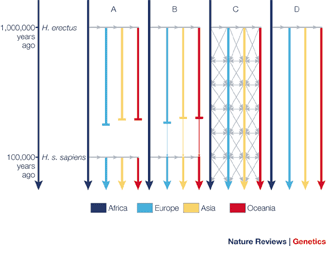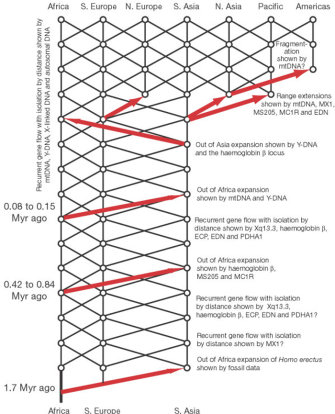« Prev Next »
The study of human genetics has added a new layer of evidence to the story of how human beings evolved and migrated on Earth.
Genetically, humans are far more similar than they are different; moreover, evolutionary changes in the genome itself are hard to tease apart, having been shuffled and reshuffled so many times. However, two mechanisms of genetic inheritance—one paternal and one maternal—do not involve recombination and have proved to be valuable tools for understanding the relationships among human beings from different continents and from different times in history.
Mitochondrial Clues from “Mitochondrial Eve"

One of the seminal papers examining the use of mtDNA to track human lineage was published in 1987. In this paper, Cann et al. considered patterns in human mtDNA samples from five different geographical regions that spanned the globe. By examining certain restriction site polymorphisms in these samples, Cann and colleagues identified 133 mitochondrial haplotypes. Using this information, the researchers concluded that the evolutionary tree of mtDNA has its roots in Africa, and that the branches of this tree are short enough to hypothesize that all humans have a fairly recent common ancestor (sometimes called "mitochondrial Eve").
Indeed, many human subpopulations carry distinct markers, and by tracing these markers through the generations, one can draw a genetic tree on which today's many diverse branches can be followed to their common African root. Thus, the surprising thing about Cann et al.'s results is not that all people have a common root, but rather how recent this root appears to be. Specifically, Cann and colleagues hypothesized that the ancestress of all of modern humanity lived only 200,000 years ago, rather than more than a million years ago, when primitive humans first walked the earth. According to Cann et al., humans who lived elsewhere in the world at the time of mitochondrial Eve were completely replaced by her descendants - modern-form humans - migrating out of Africa 100,000 years ago.
The out-of-Africa replacement hypothesis has been hotly debated. The main alternative theory is a multiregional hypothesis, credited to Australian fossil researcher Milford Wolpoff, who says that human populations in both Africa and Eurasia contributed to the evolution of anatomically modern humans (Figure 1; Wolpoff et al., 2000).
Additional Genetic Markers of Human Diversity
Just as scientists have used mtDNA to determine the relatedness of all humans, they have also used this genetic material to help determine just how different various groups of people are from one another. Modern genetic research has shown that traditional racial groups have little meaning at the genetic level (Lewontin, 1972). Rather, most of the variation in genetic polymorphisms is related to differences among individuals within populations—some 85% worth. Only about half of the remaining 15%—that which might be used to differentiate subpopulations—actually distinguishes traditional racial groups. This apportionment of variation has been confirmed by recent studies using more sensitive DNA markers (Templeton, 1997). Clearly, far more variation is found among individuals than among groups.
To track the evolution of groups, anthropological geneticists study extremely polymorphic alleles. In addition to mtDNA, human leukocyte antigen (HLA) and short tandem repeat (microsatellite) loci—nucleotide repeats, such as CACACACA—are found throughout mammalian genomes, and they have proved to be immensely useful for inferring the history of human migration.
Does Diversity Reflect Age or Number?

Enter the trellis model put forth by Alan Templeton (Figure 2). This model accepts an African origin of the human species, but it argues that this origin predates a hypothetical mitochondrial Eve, occurring approximately 1.7 million years ago. After that, multiple migrations out of Africa occurred, but the human race was never completely replaced by a single tribe. Moreover, once the three major populations (African, Asian, and European) branched out, they did not evolve in isolation. Rather, periodic movement of subpopulations allowed some genes to flow among the groups. This movement of genes accounts for Templeton's trellis design, which features lateral connections between vertical evolutionary lineages.
Templeton himself writes that the trellis model "posits the Homo erectus population not only had the ability to move out of Africa, but also back in, resulting in recurrent genetic interchange among Old World human populations. Here, there is no split of humanity into evolutionary sublineages, and the human race cannot be portrayed as branches on an evolutionary tree; rather, the genetic closeness or distance of various human populations reflect their amount of genetic interchange and not their time of divergence from a common ancestral population. Under the trellis model, anatomically modern traits could evolve anywhere in the range of Homo erectus (which includes Africa) and subsequently spread throughout all of humanity by selection and gene flow."References and Recommended Reading
Cann, R. L., et al. Mitochondrial DNA and human evolution. Nature 325, 31–36 (1987) (link to article)
Jorde, L. B., et al. The distribution of human genetic diversity: A comparison of mitochondrial, autosomal, and Y-chromosome data. American Journal of Human Genetics 66, 979–988 (2000) doi:10.1086/302825
Lewontin, R. C. The apportionment of human diversity. Evolutionary Biology 6, 381–398 (1972)
Sigurgardottir, S., et al. The mutation rate in the human mtDNA control region. American Journal of Human Genetics 66, 1599–1609 (2000)
Templeton, A. R. Out of Africa? What do genes tell us? Current Opinion in Genetics and Development 7, 841–847 (1997)
Watson, E., et al. mtDNA sequence diversity in Africa. American Journal of Human Genetics 57, 523–538 (1996)
Wolpoff, M. H., et al. Multiregional, not multiple origins. American Journal of Physical Anthropology 112, 129–136 (2000)



 Figure 1: Out-of-Africa versus the multiregional hypothesis
Figure 1: Out-of-Africa versus the multiregional hypothesis


























